Dwarf Japanese Maples (Including Weeping): Types, Leaves (With Pictures) – Identification
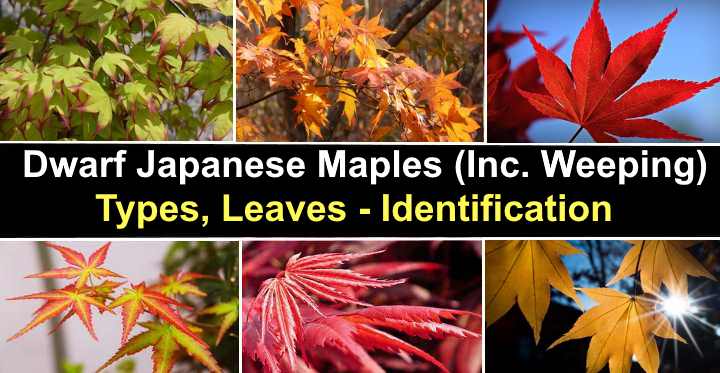
Dwarf Japanese maple trees are small decorative landscape trees with colorful ornamental palmate leaves. Small varieties of Japanese maples are ideal for small gardens, growing in containers, or miniature lawn trees. A stunning feature of dwarf Japanese maples is their red, orange, yellow, purple, green, and pink leafy foliage. Typically, dwarf varieties of Japanese maples grow between 3 and 10 ft. (1 – 3 m) tall.
There are many types of compact Japanese maple trees to plant in your yard. Different dwarf Japanese maple varieties have different colored leaves. Some small Japanese maple trees have lacy, feathery leaves that have a spiky look. Other dwarf Japanese maples have leaves with five to seven lobes, like traditional maple trees.
There are also some spectacular varieties of dwarf weeping Japanese maple trees to choose from. These small, elegant trees with cascading, drooping branches are perfect where garden space is limited.
This article describes the features of the best dwarf Japanese maples that you can buy. Descriptions and pictures of Japanese maple tree leaves will help you decide on the best kind for your garden landscape.
About Dwarf Japanese Maple Trees
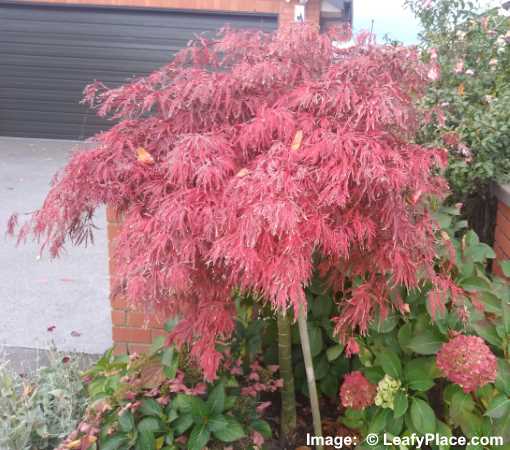
The ornamental dwarf Japanese maple tree provides stunning autumn color
Dwarf Japanese maple trees (Acer palmatum) are small or miniature trees or shrubs in the genus Acer and Sapindaceae family. Unlike tall maples that can reach 30 ft. (10 m) tall, dwarf ornamental maples don’t grow more than 10 ft. (3 m) high. Typically, dwarf Japanese maples are grown for their beautiful colorful foliage and decorative value.
The beauty of Japanese maple trees under 10 ft. (3 m) is that they offer year-round ornamental interest. Colorful leafy foliage appears in spring and persists until fall. Then the maple leaves transform into brilliant and vibrant fall colors. Most ornamental dwarf Japanese maples have a beautiful branch structure or colored bark to provide winter interest.
How to Choose the Right Dwarf Japanese Maple Tree

There are many types of dwarf Japanese maple trees to suit every garden
Five main factors can affect your choice of dwarf Japanese maple tree. There is height, leaf color, leaf shape, growth habit, and growing zone to consider.
Here are some facts about choosing a dwarf Japanese maple tree:
Height: Most people grow dwarf Japanese maples for their compact sizes. The smallest dwarf Japanese maples are around 3 ft. (1 m) tall, and the tallest are 10 ft. (3 m).
Leaf color: A characteristic of all Japanese maples—including dwarf ones—is their colorful foliage. Few ornamental trees match these maples in terms of leaf color. Some dwarf cultivars have foliage in three colors—spring, summer, and fall when the maple leaves drop.
Leaf shape: Dwarf Japanese maples are divided into two groups depending on leaf shape—palmate leaf and laceleaf (also called cutleaf maples).
Growth habit: Small, compact Japanese maples can have an upright, spreading vase shape, a rounded crown, or weeping growth habit.
USDA growing zones: Most dwarf Japanese maples are hardy in USDA zones 5 through 8. However, some species grow in zone 4 with protection and zone 9.
Dwarf Japanese Maple Trees Care
Dwarf Japanese maples are easy to care for as long as they grow in well-draining soil that is kept moist.
Grow Japanese maples in a sunny spot that gets at least four hours of daily sunshine. Water the ground to keep it moist but never soggy. Yearly pruning in late summer or fall helps encourage good growth. It’s not necessary to fertilize the small trees as the maples can lose their bushy shape.
Growing Japanese Maples in Pots or Containers
Small Japanese maples are ideal for growing in containers. The features of Japanese maples make them suitable as potted patio plants. They are slow-growing, small, and look elegant with their delicately cut leaves.
To grow a potted Japanese maple, pick a dwarf variety under 10 ft. (3 m). The slow-growing small trees should be planted in a loose, well-draining potting mix. Also, ensure the large container has holes for drainage. Water the dwarf Japanese maple regularly to keep the soil moist without becoming waterlogged.
Here are some other tips on growing dwarf Japanese maple trees in containers:
- Fertilize sparingly in spring with a diluted houseplant fertilizer
- Repot or prune the roots when you see roots poking out the container
- Prune branches in midsummer to keep the miniature maple tree’s shape
Dwarf Japanese Maple Tree Leaves

Dwarf Japanese maple leaves vary in their shape, color and size
Dwarf Japanese maples have two types of leaves—palmate lobed leaves and laceleaf. The identifying feature of Dwarf Japanese maple leaves is five to nine deep lobes. Also, the blade edges are serrated, with the most elegant maple leaves having cut or dissected leaves.
Laceleaf Japanese maple trees (Acer palmatum dissectum) are identified by their feathery fern-like leaves with deep cuts along the margins. The leaves appear to be sliced up, giving them the other names cutleaf or threadleaf Japanese maples.
Palmate Japanese maple trees (Acer palmatum) are broad, deciduous leaves with five to nine lobes. The leaves on dwarf Japanese maples have fine serration along the blade margins.
Dwarf Japanese maples are deciduous trees. This fact means that they lose their leaves in the wintertime. However, before the maple leaves drop, they fill garden landscapes with stunning vibrant fall colors. Usually, the leaves drop in November or December.
Ornamental maple leaf colors are another compelling reason to grow dwarf Japanese maples in your yard. The foliage on most dwarf Japanese maples emerges in spring in one color, turns red, green, or purple in the summer, then transforms into stunning colors in the fall. Colors of compact Japanese maple leaves include red, golden yellow, green, orange, purple, maroon, and variegated green and pink.
Dwarf Japanese Maple Trees (With Pictures)
Let’s look in more detail at some of the best examples of compact, small Japanese maple trees to grow in your garden or containers.
Crimson Queen Dwarf Japanese Maple (Acer palmatum dissectum ‘Crimson Queen’)
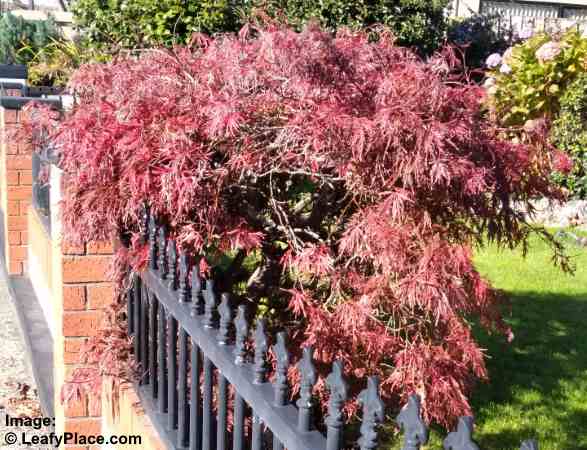
Crimson Queen Dwarf Japanese Maple
The ‘Crimson Queen’ is a spectacular shrub-like dwarf Japanese maple tree with vibrant feathery leaves. The appealing feature of this dwarf maple is the fact its lacy leaves stay rich red colors throughout the season. Due to its short stature, the ‘Crimson Queen’ is ideal for container growing as a patio plant.
The dwarf Japanese maple grows between 8 and 10 ft. (2.4 – 3 m) tall and up to 12 ft. (3.6 m) wide. Grow the elegant ‘Crimson Queen’ maple in full sun or partial shade. Unlike other dwarf maples, full sun doesn’t bleach the vibrant scarlet foliage in the summer.
Dwarf Japanese maple leaves: ‘Crimson Queen’ Japanese maple leaves are lobed, lace leaves with dissected blades and seven to nine lobes. The leaves are bright scarlet red from spring until fall.
Shaina Small Japanese Maple (Acer palmatum ‘Shaina’)
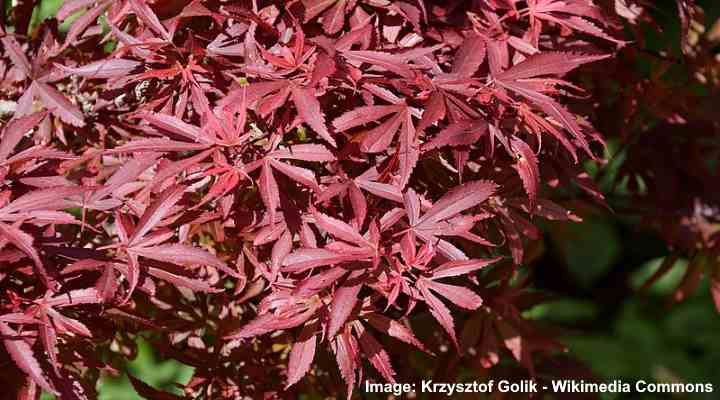
Shaina Japanese Maple
The ‘Shaina’ Japanese maple is a small ornamental tree with cascading branches and mounding growth habit. The red, maroon, and crimson-red leaves give the container tree decorative appeal in three seasons. The dense foliage keeps its intense colors throughout summer.
The dwarf ‘Shaina’ maple grows between 4 and 6 ft. (1.2 – 1.8 m) tall and 4 ft. (1.2 m) wide. The slow-growing maple thrives in full sun or partial shade. However, it is not tolerant of drought and needs to be well-watered in hot weather.
The rounded shape, densely growing leaves, and arching branches make the ‘Shaina’ maple ideal for compact gardens or container growing.
Dwarf Japanese maple leaves: ‘Shaina’ dwarf Japanese maple leaves are palmate and dark maroon, changing to bright red in the fall. Each leaf has five-pointed leaflets, and the leaf measures 2” to 5” (5 – 12 cm) long.
Laceleaf Japanese Maple ‘Garnet’ (Acer palmatum var. dissectum ‘Garnet’)

Garnet Laceleaf Japanese Maple
The dwarf Japanese maple tree ‘Garnet’ has beautiful ferny cut leaves that emerge red-orange and turn to purplish-green in the fall. The small Japanese maple tree has a spreading habit with arching branches, giving the dwarf tree an attractive rounded look. The bushy Japanese maple is prized for its low-spreading habit and beautiful foliage.
The dwarf laceleaf ‘Garnet’ maple grows between 6 and 8 ft. (1.8 – 2.4 m) tall and up to 12 ft. (3.6) wide. The compact backyard maple’s foliage is most spectacular in partial shade; however, it holds up well in full sun.
Dwarf Japanese maple leaves: ‘Garnet’ Japanese maple leaves are red-orange in spring and summer and become purple before dropping. The seven-lobed cut leaves have a feathery look, adding to the ornamental appeal of the small maple tree.
Orange Dream Japanese Maple (Acer palmatum ‘Orange Dream’)
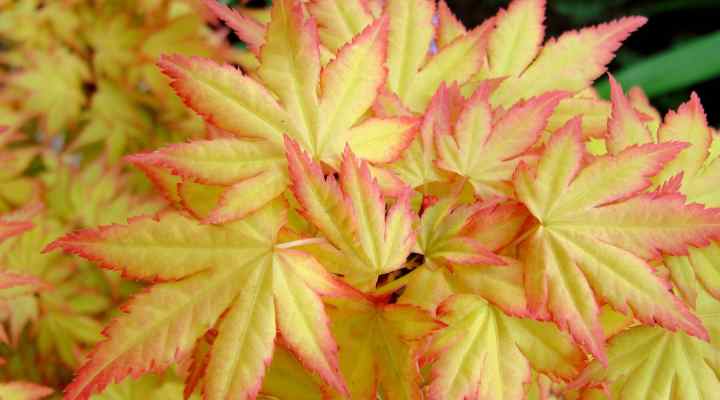
‘Orange Dream’ dwarf Japanese maple
The dwarf Japanese maple ‘Orange Dream’ has beautiful palmate golden-yellow leaves with pink tinges on the margins. The ‘Orange Dream’ is one of the many decorative maples that have yellowish-green summer leaves. In the fall, the foliage turns brilliant orange. Its slow growth and compact shape are ideal for growing in containers or small gardens.
The ‘Orange Dream’ Japanese maple grows between 8 and 10 ft. (2.4 – 3 m) tall and only 6 ft. (1.8 m) wide. Its upright, spreading branches create an eye-catching vase shape.
Dwarf Japanese maple leaves: The dwarf ‘Orange Dream’ ornamental maple leaves are seven-lobed palmate leaves with serrated edges. Leaf colors are yellow, pink, chartreuse, and bright orange.
Viridis Japanese Maple (Acer palmatum var. dissectum ‘Viridis’)
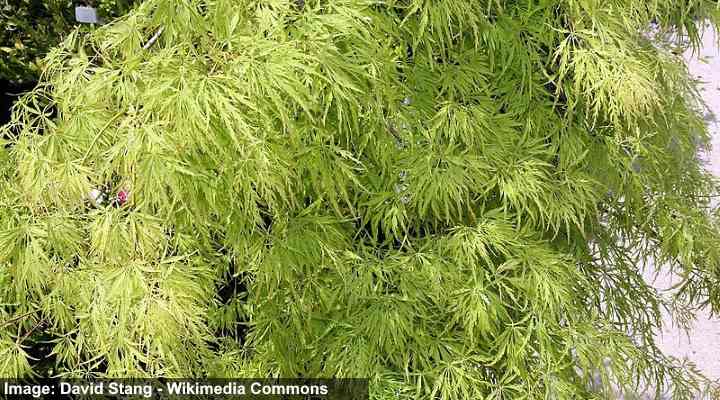
Acer palmatum ‘Viridis’
The ‘Viridis’ green dwarf Japanese maple tree has cascading branches with lacy leaves that have thin, dissected lobes. The fern-like Japanese maple leaves form an attractive rounded crown. The ‘Viridis’ Japanese maple has winter appeal due to its elegantly twisted branches visible when the feathery leaves drop.
The ‘Viridis’ cultivar is in the Acer palmatum var. dissectum group. The bushy Japanese maple tree grows 6 to 10 ft. (1.8 – 3 m) tall and wide. This excellent specimen tree is ideal as a container plant for patios or decks. Suitable for growing in USDA zones 5 to 8.
Dwarf Japanese maple leaves: The ‘Viridis’ cultivar has feathery cut leaves that emerge green and stay green throughout summer. In fall, the spiky-looking leaves turn golden yellow with hints of bright red.
Green Mist Dwarf Japanese Maple (Acer palmatum var. dissectum ‘Green Mist’)
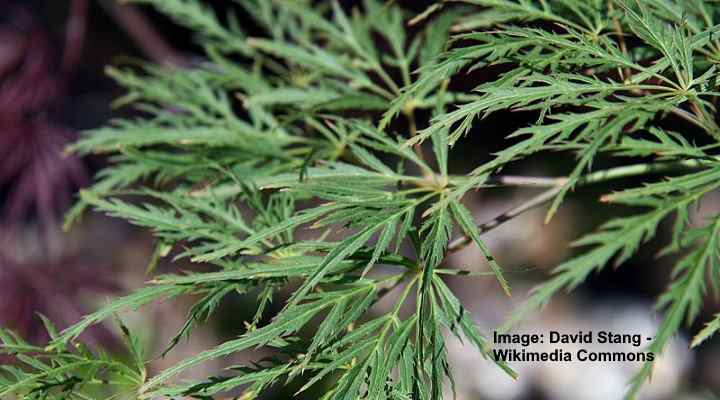
Acer palmatum var. dissectum ‘Green Mist’
The ‘Green Mist’ dwarf decorative maple tree is a mounding plant with graceful cascading foliage. The slow-growing Japanese maple takes about 20 years to mature at 5 or 6 feet (1.5 – 1.8 m) tall. Its cascading branches tend to grow outward, giving the elegant bushy maple a rounded, dense shrub-like appearance.
The ‘Green Mist’ Japanese maple grows relatively fast to about 3 ft. (1 m) tall and up to 5 ft. (1.5 m) wide. The hardy, showy maple thrives in USDA zones 5 to 9.
Dwarf Japanese maple leaves: The ‘Green Mist’ is characterized by feathery, lacy leaves with long, cut lobes. The delicate foliage emerges bright green and turns orangey-yellow or scarlet red in the fall before the maple leaves drop.
‘Fireglow’ Small Japanese Maple (Acer palmatum ‘Fireglow’)
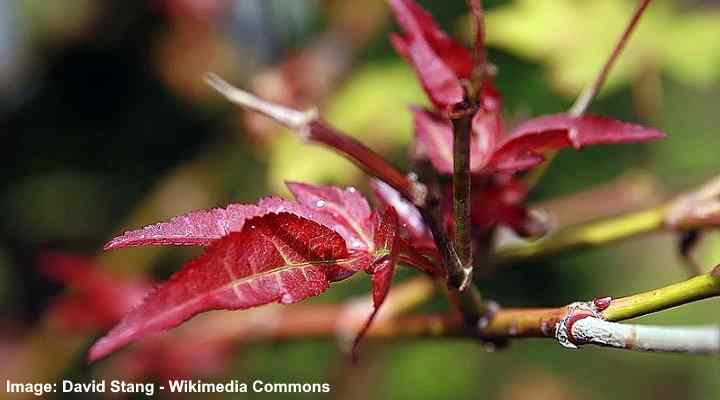
Fireglow small Japanese Maple Tree
The ‘Fireglow’ palmate Japanese maple is a small sized ornamental red-leaved tree. This slow-growing shrubby tree is ideal for compact, small spaces or container growing. Its spectacular red leaves have slender lobes. The ever-changing foliage color provides year-long visual appeal.
The Fireglow Japanese maple takes ten years to grow between 6 and 10 ft. (1.8 – 3 m) tall and 15 ft. (4.5 m) wide. The beautiful single-stemmed tree has branches and a spreading, rounded canopy. Grow in containers or small gardens in USDA zones 5 to 9.
Dwarf Japanese maple leaves: The eye-catching palm-like leaves of the ‘Fireglow’ Japanese maple have distinctive red shades. In spring, the lobed maple leaves are pink-red before turning green with red blushing then purple-red in the fall.
‘Red Pygmy’ Dwarf Japanese Maple (Acer Palmatum ‘Red Pygmy’)
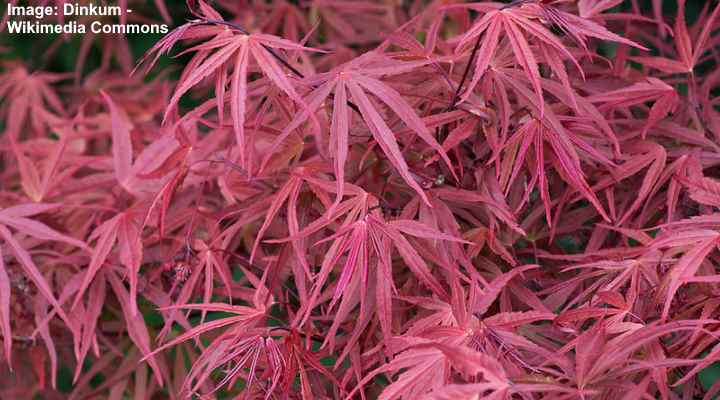
Red Pygmy Japanese maple
The ‘Red Pygmy’ dwarf Japanese maple tree is one of the smallest ornamental Japanese trees for your garden. The decorative container tree takes 20 years to reach a mature height and spread of 5 ft. (1.5 m). The Japanese maple ‘Red Pygmy’ has leaves with long, thin wispy lobes and serrated edges.
The ornamental stems create a bushy appearance, making this a desirable Japanese maple for small gardens.
Grow the ‘Red Pygmy’ dwarf Japanese maple in USDA zones 6 to 8.
Dwarf Japanese maple leaves: The ‘Red Pygmy’ leaves have long, delicate finger-like leaves that are maroon in spring and summer before turning yellow, green, orange, or red in the fall.
Ornatum Japanese Maple (Acer palmatum ‘Ornatum’)
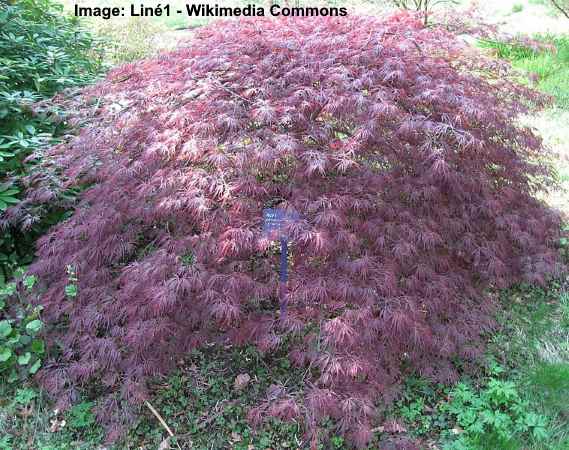
Ornatum Japanese Maple
The ‘Ornatum’ cultivar is a slow-growing Japanese maple that has delicate lacy leaves with long thin lobes that are bronze-red in spring. The foliage turns bronze-orange in summer and bright red in fall. The Ornatum maple tree has a rounded growth habit. This small Japanese maple tree grows up to 10 ft. (3 m) tall with a spread of 8 – 10 ft. (2.4 – 3 m).
Grow in full sun to part shade in moist and well-drained soil in zones 5 – 8.
Dwarf Weeping Japanese Maple Trees (With Pictures)
Dwarf weeping Japanese maple trees create a dramatic effect in small gardens with their arching, cascading branches that droop to the ground.
Here are some of the best small and miniature Japanese maple trees with weeping growth.
Red Dragon Dwarf Weeping Maple Tree (Acer palmatum dissectum ‘Red Dragon’)
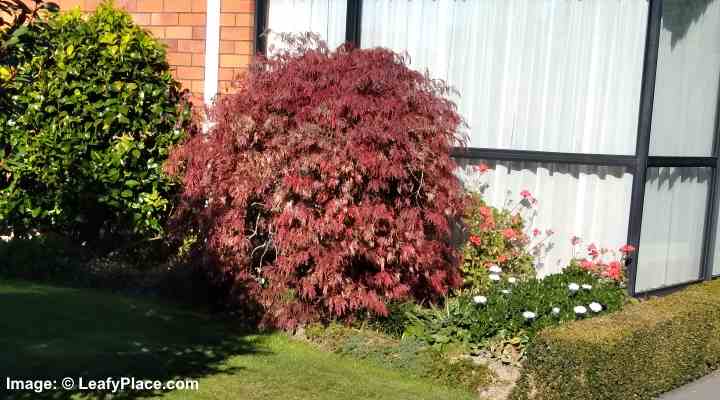
Red Dragon dwarf weeping Japanese maple
The ‘Red Dragon’ dwarf Japanese maple tree has upright growth with cascading branches creating a visually attractive maple bush. As a threadleaf Japanese maple, the ‘Red Dragon’ has lace-like leaves with cut lobes. The beautiful foliage is various shades of red throughout the seasons.
‘Red Dragon’ matures between 4 and 6 ft. (1.2 – 1.8 m) high, creating a pendulous mound. The arching branches are covered in reddish foliage, which keeps its color growing in full sun. This weeping dwarf maple thrives in USDA zones 5 to 8.
Dwarf Japanese maple leaves: The maple leaves on the dwarf ‘Red Dragon’ look like a dragon’s claws. The deeply-cut, thin, ferny leaves emerge bright red, turn deep burgundy, then become crimson red before dropping in the fall.
Inaba Shidare Dwarf Japanese Maple (Acer palmatum dissectum ‘Inaba Shidare’)
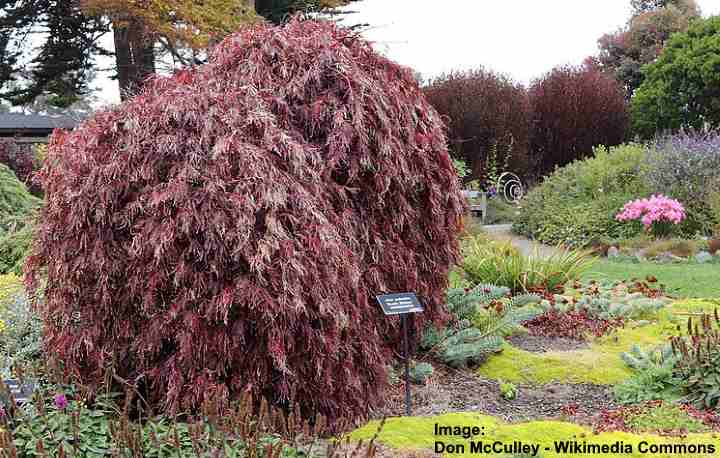
Inaba Shidare dwarf weeping Japanese maple
The ‘Inaba Shidare’ dwarf Japanese maple tree has an elegant cascading form, fen-like dissected leaves, and deep red and purple colors. It takes about ten years for the dwarf ornamental maple to reach 6 ft. (1.8 m) tall. The ‘Inaba Shidare’ low-spreading pendulous growth gives the shrubby Japanese maple tree a bushy appearance.
‘Inaba Shidare’ dwarf Japanese maple trees eventually mature at 10 ft. (3 m) tall and 15 ft. (4.5 m) wide. The attractive maple thrives in USDA zones 5 to 9. In hot climates, grow the weeping dwarf tree in partial shade to protect its foliage color.
Dwarf Japanese maple leaves: The ‘Inaba Shidare’ tree leaves have dissected lobes and a lacy appearance. The leaves are hues of purple throughout the growing season. The fern-like maple leaves measure 6” (15 cm) long.
Dissectum Atropurpureum Dwarf Japanese Maple (Acer palmatum ‘Atropurpureum Dissectum’)
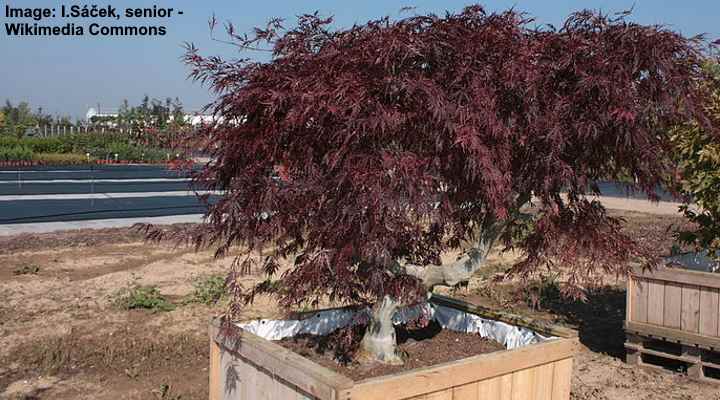
Dwarf weeping Japanese maple ‘Atropurpureum Dissectum’
The botanical name dissectum shows this weeping dwarf Japanese maple has ferny leaves with deep incisions on the long, thin, pointed lobes. The outstanding features of the ‘Dissectum Atropurpureum’ are its brightly autumn colored red leaves and spreading cascading growth. When the maple loses its leaves in winter, you can enjoy the fascinating shapes of the crooked, twisting, and contorted branches.
The dwarf ‘Dissectum Atropurpureum’ takes many years to mature at 8 ft. (2.4 m) tall and wide. Grow this beautiful small-size red maple in containers, compact gardens, or as a lawn tree in zones 6 to 8.
Dwarf Japanese maple leaves: The ‘Dissectum Atropurpureum’ maple has lace-like leaves with long, thin cut blades. The maple leaves emerge purple, turn bronze-green, and become a fiery orangey-red color in the fall.
Dwarf Weeping Japanese Maple tree ‘Waterfall’ (Acer palmatum dissectum ‘Waterfall’)
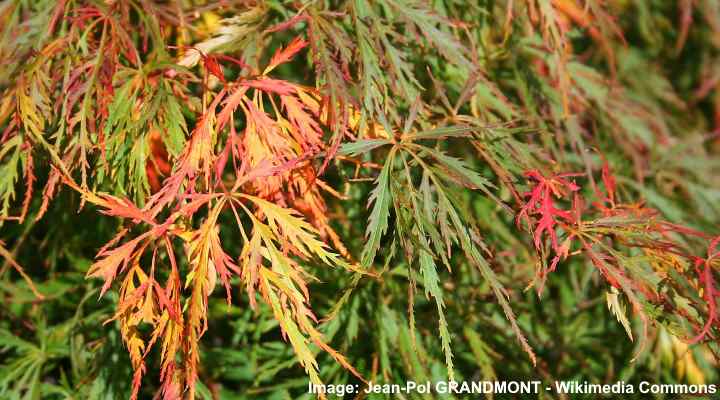
Acer palmatum dissectum ‘Waterfall’
The ‘Waterfall’ weeping Japanese maple is a small, bushy tree with feathery ornamental leaves. As a type of green Japanese maple, the lace-like leaves are dark green during summer. In the fall, the threadleaf maple foliage turns shades of yellow, orange, and red.
As the Japanese maple cultivar name suggests, the outstanding feature of this dwarf tree is its cascading branches. The drooping branches create a ‘waterfall’ of green foliage in summer and orange-red leaves in the fall.
‘Waterfall’ dwarf maples are ideal as container plants. The rounded, umbrella-like crown measures up to 12 ft. (3.6 m) wide, and the dwarf maple is 6 to 10 ft. (1.8 – 3 m high).
Dwarf Japanese maple leaves: The ‘Waterfall’ Japanese maple has long, thin dissected lobes that are cut to the stem. Each lacy maple leaf turns vibrant shades of reds and yellows in the fall, creating stunning ornamental value.
Japanese Maple Bonsai
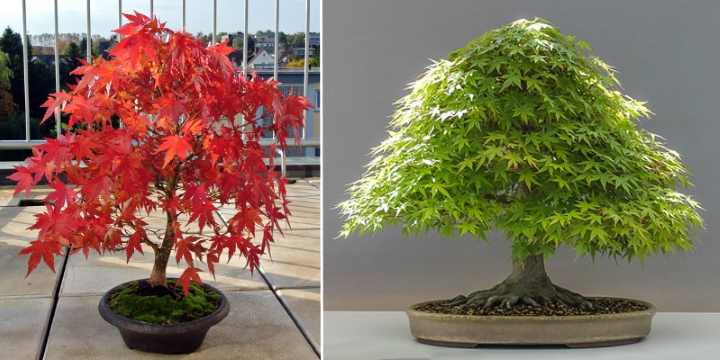
Japanese Maple Bonsai
Japanese maple trees with their naturally contorted and twisted branches make ideal bonsai trees. Miniature Japanese maple bonsai trees produce the same vibrantly colored foliage in the spring and fall of the full-sized maples.
Here are some popular Acer palmatum varieties that are ideal for growing as miniature Japanese maple trees:
Acer palmatum ‘Deshojo’—Red-leaved miniature maple with broad leaves.
Acer palmatum ‘Seigen’—A laceleaf maple bonsai variety with red leaves in the summer.
Acer palmatum ‘Katsura’—An orange-leaved Japanese bonsai with palmate leaves.
Acer palmatum atropurpureum—This miniature maple has dark red leaves in the summer.
Acer palmatum ‘Shishigashira’—This interesting maple bonsai has curled leaves with a shrubby growth.
Related articles:
